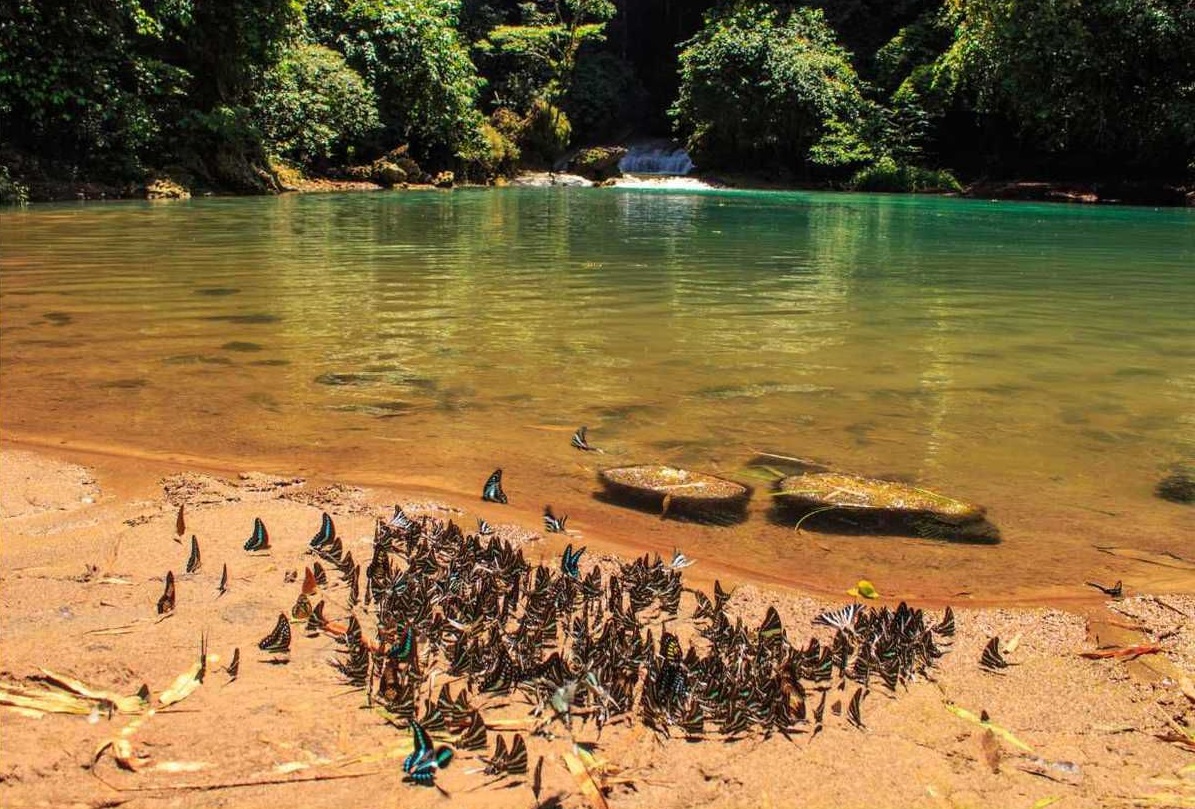Bantimurung National Park is located in South Sulawesi Province with an area of approximately 43,750 hectares. Bantimurung National Park has various uniqueness and among them are the karst, caves with beautiful stalactites and stalagmites. And the most famous is the butterfly.
This National Park is a tourist destination that offers many types of natural objects. Existing natural attractions such as the steep limestone valleys with tropical vegetation, waterfalls and caves are habitat for various species of fauna, including butterflies.
Bantimurung features butterflies as its main attraction. In this place there are at least 20 protected species of butterflies. Some unique species are even categorized as endemic.

Bantimurung by researcher Alfred Russel Wallace was dubbed as The Kingdom of Butterfly. He researched this location between the years 1856-1857. According to Wallace’s research, there are at least 250 species of butterflies in this park. It has also two caves that can be used as special interest tours. The two caves are Batu (Stone) Cave and Mimpi (Dream) Cave.
Meanwhile, around the Bantimurung National Park there are also various interesting ecotourism locations. There are more than 80 natural caves and prehistoric caves scatter around the karst area of Bantimurung National Park.
Bantimurung National Park Location
According to government administration, Bantimurung National Park area is located in Maros and Pangkep Regencies. This park is not far from the South Sulawesi provincial capital, Makassar.
Route to Bantimurung National Park
Bantimurung National Park can be reached using private vehicles, both motorbikes and cars. You can also take “pete-pete” or public transportation in the local language. The access is also quite easy with smooth asphalt roads. From Makassar, this place can be reached in about 1-2 hours.
To go to Bantimurung, the most reliable public transportation is pete-pete. From Makassar City, look for pete-pete that heading to Terminal Daya. Then from Terminal Daya take a pete-pete to Pangkajene and get off at Maros. After getting off in front of the Maros Market, look for another pete-pete heading to Bantimurung.

Credit: BisnisWisata
Bantimurung National Park Tourist Attraction
Various types of interesting tourist activities can be done in Bantimurung National Park area. Here are eight of the top tourist attractions, which authenticindonesia.com try to summarize as reference for potential visitors.
1. Bantimurung Tourism Area
This tourist area has indeed been opened to the public and has become a leading tourist destination in Maros Regency. Here, you can see various kinds of natural beauty such as waterfalls, river flows between steep cliffs, clear lakes and many more.
You will also be offered to a very soothing view of the hundreds of butterfly species flying freely. There are about 250 species of butterflies that live in this area. That’s why this place is called The Kingdom of Butterfly.
2. Helena Sky Bridge
In the butterfly dome of Bantimurung National Park, visitors will be offered to a world of butterflies. Your eyes will be amazed endlessly watching the beautiful fluttering of butterfly wings, dancing nimbly, snaking around visitors and then perching on flowers.
The Helena Sky Bridge rides is right across the butterfly captivity of Bantimurung Bulusaraung National Park. Standing firmly with twin towers as high as approximately 20 meters, the suspension bridge has a length of 50 meters stretching over a butterfly breeding area of 7000 square meters.
To reach the Helena Sky Bridge, visitors must do tracking first. After that, the journey continues by crossing a 50 meter long suspension bridge on a cliff slope with an altitude of approximately 100 meters above sea level.
3. Leang-Leang Prehistoric Region
This location offers a tour of the cultural history of ancient human civilization. You can trace prehistoric human life here. There are paintings of human palms and deer pigs emblazoned on the cave walls as well as various artifacts in the area.
This prehistoric area also offers captivating views. Clusters of rock cliffs with distinctive towering shape forms a distinctive panorama of karst walls. The distance is about three kilometers from Bantimurung Tourism Park.
4. Pattunuang Tourist Area
If you like challenging adventurous activities, this is the place to be. There are many options that you can do here, such as rock climbing on towering karst walls, going along vertical or horizontal caves or going along rocky rivers and clear water. You can also camp to enjoy the outdoors, explore trails in the forest or hike in the karst hills.
The Pattunuang area also offers various types of wild plants and animals that roam their natural habitat. Such as the rare primate Tarsius Fuscus, Soa-Soa and dozens of bird species. In a separate location, there is also the legend of “Biseang Labboro” or the petrified overturned boat on the banks of the Pattunuang River. Pattunuang is located in Samangki Village, Simbang District, Maros.
5. Leang Puteh Vertical Cave Area
Still in Labuaja Village, this place is a perfect location for the most challenging adventurers in Bantimurung Bulusaraung National Park. The vertical cave is wide open and deep enough to pump up adrenaline seekers. With a width of 50-80 meters and a depth of about 273 meters, Leang Puteh is a cave with the deepest single pitch category in Indonesia.
At the base, this cave connects with Dinosaur Cave which is located not far from the mouth of Leang Puteh Cave. To navigate this location, it takes special skills and expertise and standard equipment as well.
6. Karaenta Animal Observation Area
Karaenta, in Labuaja Village, is known as natural laboratory that offers a variety of interesting knowledge and experiences. It is because of the richness of flora and fauna and the unique natural scenery that is interesting to explore.
In the Karaenta there is a group of Macaca Maura primates. With the special expertise of the local officers, the black ape group can gather and become natural animal attractions in their natural habitats. There is also a cluster of ebony, which is a rare and highly valuable type of wood.




